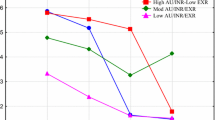Abstract
According to the cognitive approach to motivation and decision, the choice among alternative actions is in fact the choice among outcomes that differ in their value and their probability. These outcomes can either be goals in themselves or the means of achieving goals (i.e., instrumental values). Clear examples of choices associated with the first type of outcome are moral decisions, while examples of choices connected with the second type of outcome are economic decisions.
The first study reported in the present paper was designed in order to compare two models for predicting choices among alternative efforts in a work setting. The second study was designed in order to investigate possible reasons for the lack of predictive success of this whole class of models. This study too was carried out in an industrial setting.
Access this chapter
Tax calculation will be finalised at checkout
Purchases are for personal use only
Preview
Unable to display preview. Download preview PDF.
Similar content being viewed by others
References
Arvey, R.D. (1972). Task performance as a function of perceived effort-performance and performance-reward contingencies. Organizational Behavior and Human Performance, 8, 423–433.
Broedling, L.A. (1975). Relationship of internal-external control to work motivation and performance in an expectancy model. Journal of Applied Psychology, 60, 65–70.
Dachler, H.P., & Mobley, W.H. (1973). Construct validation of an instrumentality-expectancy-task-goal model of work motivation: Some theoretical boundary conditions. Journal of Applied Psychology Monograph, 58, 397–418.
Edwards, A.L. (1957a). Social desirability and probability of endorsement of items in the interpersonal check list. Journal of Abnormal Psychology, 55, 394–396.
Edwards, A.L. (1957b). The social desirability variable in personality assessment and research. New York: Dryden Press.
Feldman, D.C., & Arnold, W.J. (1978). Position choice: Comparing the importance of organizational and job factors. Journal of Applied Psychology, 63, 706–710.
Fischer, E.W. (1976). Multidimensional utility models for risky and riskless choice. Organizational Behavior and Human Performance, 17, 127–146.
Goldberg, L.B. (1968). Simple models or simple processes? American Psychologist, 23, 483–496.
Graen, G. (1969). Instrumentality theory of work motivation: Some experimental results and suggested modifications. Journal of Applied Psychology Monograph, 53, 2, Part 2.
Jorgenson, D.O., & Dunnette, M.D. (1973). Effects of the manipulation of a performance-reward contingency on behavior in a simulated work setting. Journal of Applied Psychology, 57, 271–280.
Lawler, E.E., & Porter, L.W. (1967). Antecedent attitudes of effective managerial performance. Organizational Behavior and Human Performance, 2, 122–142.
Lawler, E.E., & Suttle, J.L. (1973). Expectancy theory and job behavior. Organizational Behavior and Human Performance, 19, 482–503.
Mitchell, T.R. (1974). Expectancy models of job satisfaction, occupational preference, and effort: A theoretical, methodological, and empirical appraisal. Psychological Bulletin, 81, 1053–1077.
Mitchell, T.R. (1979). Organizational behavior. Annual Review of Psychology, 30, 243–282.
Mitchell, T.R., & Beach, L.R. (1979). A review of occupational preferences and choice research using expectancy theory and decision theory. Journal of Occupational Psychology, 49, 231–248.
Mitchell, T.R., & Nebeker, D.M. (1973). Expectancy theory predictions of academic effort and performance. Journal of Applied Psychology, 57, 61–67.
Nebeker, D.M., & Mitchell, T.R. (1974). Leader behavior: An expectancy theory approach. Organizational Behavior and Human Performance, 11, 355–367.
Pritchard, R.D., & De Leo, PJ. (1973). Experimental test of the valence-instrumentality relationship in job performance. Journal of Applied Psychology, 57, 264–270.
Pritchard, R.D., & Sanders, M.B. (1973). The influence of valence, instrumentality, and expectancy on effort and performance. Journal of Applied Psychology, 57, 55–60.
Rotter, J. B. (1954). Social learning and clinical psychology. New York: Prentice-Hall.
Schmidt, F.L. (1973). Implications of measurement problems for expectancy theory research. Organizational Behavior and Human Performance, 10, 243–251.
Stahl, M.J., & Harrel, A.J. (1981). Modeling effort decision with behavioral decision theory: Toward an individual differences model of expectancy theory. Organizational Behavior and Human Performance, 27, 303–325.
Stahl, M.J., & Harrel, A.M. (1983). Using decisions modeling to measure second level valences in expectancy theory. Organizational Behavior and Human Performance, 32, 23–34.
Vroom, V.H. (1964). Work and motivation. New York: Wiley.
Zedeck, S. (1977). An information processing model and approach to the study of motivation. Organizational Behavior and Human Performance, 18, 47–77.
Author information
Authors and Affiliations
Editor information
Editors and Affiliations
Rights and permissions
Copyright information
© 1989 Kluwer Academic Publishers
About this chapter
Cite this chapter
Sokołowska, J. (1989). Application of the Valence-Instrumentality-Expectancy and Multiattribute Utility Models in the Prediction of Worker Effort. In: Grunert, K.G., Ölander, F. (eds) Understanding Economic Behaviour. Theory and Decision Library, vol 11. Springer, Dordrecht. https://doi.org/10.1007/978-94-009-2470-3_14
Download citation
DOI: https://doi.org/10.1007/978-94-009-2470-3_14
Publisher Name: Springer, Dordrecht
Print ISBN: 978-94-010-7614-2
Online ISBN: 978-94-009-2470-3
eBook Packages: Springer Book Archive




